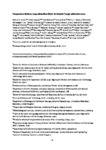Temperature limits to deep subseafloor life in the Nankai Trough subduction zone
| dc.contributor.author | Heuer, VB | |
| dc.contributor.author | Inagaki, F | |
| dc.contributor.author | Morono, Y | |
| dc.contributor.author | Kubo, Y | |
| dc.contributor.author | Spivack, AJ | |
| dc.contributor.author | Viehweger, B | |
| dc.contributor.author | Treude, T | |
| dc.contributor.author | Beulig, F | |
| dc.contributor.author | Schubotz, F | |
| dc.contributor.author | Tonai, S | |
| dc.contributor.author | Bowden, SA | |
| dc.contributor.author | Cramm, M | |
| dc.contributor.author | Henkel, S | |
| dc.contributor.author | Hirose, T | |
| dc.contributor.author | Homola, K | |
| dc.contributor.author | Hoshino, T | |
| dc.contributor.author | Ijiri, A | |
| dc.contributor.author | Imachi, H | |
| dc.contributor.author | Kamiya, N | |
| dc.contributor.author | Kaneko, M | |
| dc.contributor.author | Lagostina, L | |
| dc.contributor.author | Manners, Hayley | |
| dc.contributor.author | McClelland, H-L | |
| dc.contributor.author | Metcalfe, K | |
| dc.contributor.author | Okutsu, N | |
| dc.contributor.author | Pan, D | |
| dc.contributor.author | Raudsepp, MJ | |
| dc.contributor.author | Sauvage, J | |
| dc.contributor.author | Tsang, M-Y | |
| dc.contributor.author | Wang, DT | |
| dc.contributor.author | Whitaker, E | |
| dc.contributor.author | Yamamoto, Y | |
| dc.contributor.author | Yang, K | |
| dc.contributor.author | Maeda, L | |
| dc.contributor.author | Adhikari, RR | |
| dc.contributor.author | Glombitza, C | |
| dc.contributor.author | Hamada, Y | |
| dc.contributor.author | Kallmeyer, J | |
| dc.contributor.author | Wendt, J | |
| dc.contributor.author | Wörmer, L | |
| dc.contributor.author | Yamada, Y | |
| dc.contributor.author | Kinoshita, M | |
| dc.contributor.author | Hinrichs, K-U | |
| dc.date.accessioned | 2020-12-14T09:51:24Z | |
| dc.date.issued | 2020-12-04 | |
| dc.identifier.issn | 0036-8075 | |
| dc.identifier.issn | 1095-9203 | |
| dc.identifier.uri | http://hdl.handle.net/10026.1/16739 | |
| dc.description | No embargo required. | |
| dc.description.abstract |
<jats:p>Microorganisms in marine subsurface sediments substantially contribute to global biomass. Sediments warmer than 40°C account for roughly half the marine sediment volume, but the processes mediated by microbial populations in these hard-to-access environments are poorly understood. We investigated microbial life in up to 1.2-kilometer-deep and up to 120°C hot sediments in the Nankai Trough subduction zone. Above 45°C, concentrations of vegetative cells drop two orders of magnitude and endospores become more than 6000 times more abundant than vegetative cells. Methane is biologically produced and oxidized until sediments reach 80° to 85°C. In 100° to 120°C sediments, isotopic evidence and increased cell concentrations demonstrate the activity of acetate-degrading hyperthermophiles. Above 45°C, populated zones alternate with zones up to 192 meters thick where microbes were undetectable.</jats:p> | |
| dc.format.extent | 1230-1234 | |
| dc.format.medium | ||
| dc.language | en | |
| dc.language.iso | en | |
| dc.publisher | American Association for the Advancement of Science (AAAS) | |
| dc.subject | Acetates | |
| dc.subject | Endospore-Forming Bacteria | |
| dc.subject | Geologic Sediments | |
| dc.subject | Hot Temperature | |
| dc.subject | Methane | |
| dc.title | Temperature limits to deep subseafloor life in the Nankai Trough subduction zone | |
| dc.type | journal-article | |
| dc.type | Journal Article | |
| dc.type | Research Support, Non-U.S. Gov't | |
| plymouth.author-url | https://www.webofscience.com/api/gateway?GWVersion=2&SrcApp=PARTNER_APP&SrcAuth=LinksAMR&KeyUT=WOS:000596071300065&DestLinkType=FullRecord&DestApp=ALL_WOS&UsrCustomerID=11bb513d99f797142bcfeffcc58ea008 | |
| plymouth.issue | 6521 | |
| plymouth.volume | 370 | |
| plymouth.publication-status | Published | |
| plymouth.journal | Science | |
| dc.identifier.doi | 10.1126/science.abd7934 | |
| plymouth.organisational-group | /Plymouth | |
| plymouth.organisational-group | /Plymouth/Faculty of Science and Engineering | |
| plymouth.organisational-group | /Plymouth/Faculty of Science and Engineering/School of Geography, Earth and Environmental Sciences | |
| plymouth.organisational-group | /Plymouth/REF 2021 Researchers by UoA | |
| plymouth.organisational-group | /Plymouth/REF 2021 Researchers by UoA/UoA07 Earth Systems and Environmental Sciences | |
| plymouth.organisational-group | /Plymouth/Users by role | |
| plymouth.organisational-group | /Plymouth/Users by role/Academics | |
| dc.publisher.place | United States | |
| dcterms.dateAccepted | 2020-10-13 | |
| dc.rights.embargodate | 2020-12-16 | |
| dc.identifier.eissn | 1095-9203 | |
| dc.rights.embargoperiod | Not known | |
| rioxxterms.versionofrecord | 10.1126/science.abd7934 | |
| rioxxterms.licenseref.uri | http://www.rioxx.net/licenses/all-rights-reserved | |
| rioxxterms.licenseref.startdate | 2020-12-04 | |
| rioxxterms.type | Journal Article/Review | |
| plymouth.funder | Novel organic compounds in tephra as indicators of current and past microbial activity::NERC |


